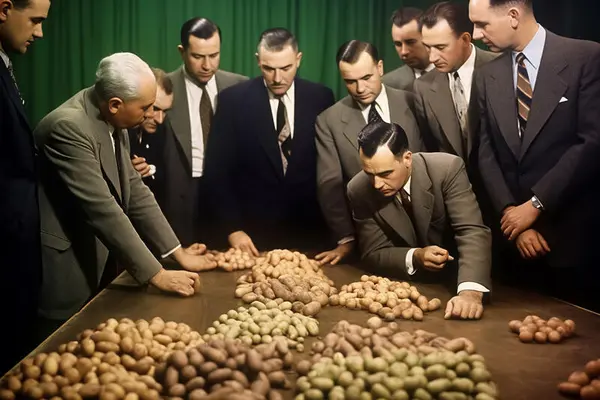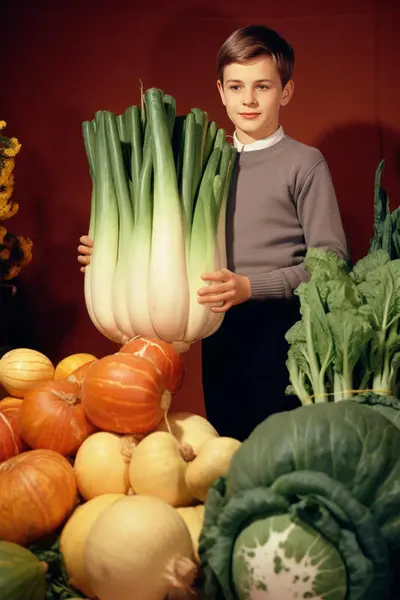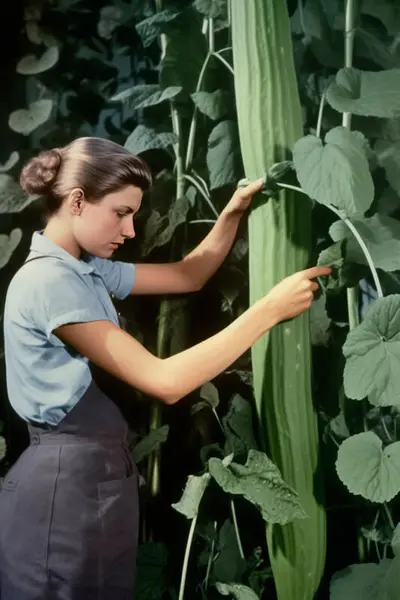- 1/1
© Bruce Eesly, New Farmer, 2023. Selected potato varieties are rated in sixteen categories according to the LURCH Desirable Traits Checklist, 1952
Bildene som vises er en del av en brosjyre med tittelen New Farmer, som fremstiller seg som et historisk dokument og ser ut til å gjenta suksesshistorien til den grønne revolusjonen: genetisk manipulasjon resulterer i nye avlingsvarianter som resulterer i større og bedre avlinger. Etter hvert som historien utfolder seg, slår den imidlertid sprekker: Kan disse gigantiske grønnsakene virkelig være ekte? Ødela vi faktisk en frøbank for å gjøre plass til en fabrikk for plantevernmidler?
- 1/1
© Bruce Eesly, New Farmer, 2023. Peter Trimmel wins first prize for his UHY fennel at the Kooma Giants Show in Limburg, 1956
Bildene grenser til troverdige før de bikker over til det absurde. De er ikke dokumentarfotografier fra 1960-tallet som brosjyren antyder, men AI-genererte bilder. Med falske bilder og humor stiller dette prosjektet spørsmål ved den dominerende fortellingen om den grønne revolusjonen, og spør:
Hvem sin historie kan vi stole på?
- 1/1
© Bruce Eesly, New Farmer, 2023. Frieda Hammer prunes a cucumber plant, 1956
Her kan du lese Bruce Eeslys prosjektbeskrivelse
New Farmer is a reimagining of the history of the Green Revolution of the 1950s, when crop scientists developed new super-productive plant varieties through selective breeding and genetic manipulation, paving the way for industrial agriculture. The images are part of a pamphlet that pretends to have been published by an agribusiness in 1967, celebrating the Green Revolution through 47 documentary photographs.
The pictures aren’t actual photographs however, but AI-generated images or synthographs. The story itself, while bearing some resemblance to actual events, is also made up: This alternative version doesn’t end in the giant fields of monocultures that surround us today, but instead brings about absurdly oversized vegetables.
For thousands of years, seeds have been collected, bred and passed on from farmer to farmer and generation to generation, creating a rich diversity of crops adapted to local conditions. We have lost 75% of this genetic variety in the last century. The Green Revolution has brought about a global food system that depends on a very narrow selection of plants, making it highly vulnerable to diseases, pests and climate extremes.
The remaining super-productive crops rely on heavy inputs of fertiliser, pesticides and water, contributing to soil degradation, pollution and water shortages. We have converted seeds into intellectual property, genetically designed to be used only once. Today, half of the world’s seed supply is in the hands of four companies.
New Farmer is a project about disinformation, the reliability of photographs and the way history is made and perceived through images. It is asking: Whose story can we trust? I’m also hoping the cognitively estranging character of the artificially generated images makes viewers think about our extractive relationship to nature (and potentially commit the revolutionary act of sowing an heirloom seed).


